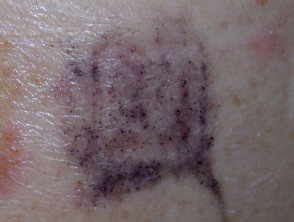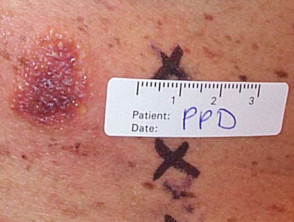What is paraphenylenediamine?
Paraphenylenediamine (PPD) is a chemical substance that is widely used as a permanent hair dye. PPD is used in hair dye because it is a permanent dye that gives a natural look, and the dyed hair can also be shampooed or permed without losing its colour.
The base PPD is colourless and requires oxygen for it to become a dye, thus PPD hair dyes are usually packaged as 2 bottles, one that contains the PPD dye and the other containing a developer or oxidiser. Darker shades of hair dye products contain higher concentrations of PPD than lighter shades. The darker shades of hair dye are often used by people with naturally dark hair.
Other uses of PPD
- Textile dyes and fur dyes
- Dark coloured cosmetics
- Dark coloured temporary henna tattoos
- Photographic developer and lithography plates
- Photocopying and printing inks
- Black rubber
- Oils, greases and gasoline.
Paraphenylenediamine and allergy
Fully oxidized PPD is not a sensitiser, but the intermediate, partially oxidised form of PPD may cause contact allergic dermatitis in sensitive individuals. Hair colour preparations containing PPD or its derivatives carry a warning on the packaging recommending a self patch test prior to use of the dye.
PPD was declared the Contact Allergen of the Year for 2006 by the American Contact Dermatitis Society (ACDS).
Who gets an allergy to paraphenylenediamine?
An allergy may arise in anybody exposed to PPD. For example:
- Hairdressers — who often apply hair dye to their clients several times each day
- Hairdressing clients — especially those using darker shades of dye, so allergy is more common in people with skin of colour than in light-skinned individuals.
- Photographers that develop film
- People who have black temporary tattoos.
The prevalence of hair dye reactions has increased in recent years as dyeing hair has become popular among males and females of all ages.
A negative result to a patch test of the dye prior to using it does not guarantee freedom from reaction, because the patch test itself could cause sensitisation and result in a rash the next time the hair is dyed.
What are the clinical features of allergy to PPD?
PPD allergy usually presents as acute, subacute, or chronic allergic contact dermatitis on areas in direct contact with the dye. The exposure that initiates the reaction may not cause symptoms; contact dermatitis occurs with subsequent contact with PPD and tends to occur more quickly (from a few hours to a few days after contact), becomes increasingly severe and extensive, and persists for longer.
- A mild reaction to hair dye in a client usually presents as an itchy dry rash on the upper eyelids (see eyelid dermatitis) and/or the rims of the ears.
- More severe reactions cause marked reddening, blistering and swelling of the eyelids, scalp, face and neck.
- High concentrations of PPD in black temporary tattoos may result in intense blistering reactions at the site of the tattoo within 1–2 days of tattooing; a lichenoid eruption may arise 1–2 weeks later.
- Dermatitis may become widespread, due to direct contact or to autoeczematisation.
- People working with PPD, such as hairdressers and photographers developing film, may develop hand dermatitis. Dermatitis may spread to the arms, chest and elsewhere due to autoeczematisation.
- Dermatitis may be followed by post-inflammatory hyperpigmentation, hypopigmentation or scarring.
- After the reaction subsides, lifelong sensitisation to PPD is likely.
PPD allergy may also rarely present as erythema multiforme or contact urticaria. PPD has also been suspected of precipitating contact leukoderma and vitiligo in genetically predisposed individuals.
Systemic reactions to PPD have also been reported, such as asthma, anaphylaxis and acute renal failure.
Contact allergy to p-phenylenediamine in hair dye
How is paraphenylenediamine allergy diagnosed?
PPD allergy may be suspected clinically and is confirmed by patch testing. Patients having a clear history of allergy to hair dye or black henna tattoos are best tested with a lower 0.3% PPD concentration than in the baseline series of allergens, to avoid a severe blistering patch test reaction.
There are two methods of patch testing.
Uncovered patch tests
The uncovered method is recommended to consumers prior to using hair dye. Instructions for testing should be included with every package of hair dye.
- The test involves applying a 20 cent sized spot of solution (ie, dye and developer mixed together) to either the neck (behind the ear) or the inner bend of the elbow.
- Allow to dry and leave uncovered for 48–72 hours.
- If no irritation or rash occurs during this time the test is negative and one can assume that the risk of developing a rash is less than if the test is positive.
- Immediate irritation or rash within minutes or a few hours is more likely to be irritant contact dermatitis than allergic contact dermatitis.
- A delayed reaction with redness, swelling, blistering or dryness at the site of the test indicates that dermatitis will develop if the mixture is used to dye the hair.
- The severity of the reaction is compared to a scale and recorded as 1+ or 2+.
However, be warned that testing to hair dye could induce a primary allergic reaction to it.
Covered patch tests
Dermatologists and allergy specialists use covered patch tests to determine PPD sensitivity.
- Patch testing is undertaken using 2% PPD in petrolatum.
- A negative result usually means the individual can use PPD hair dyes without difficulty
- A +/- reaction is irritant or indeterminate and indicates that the individual should use PPD hair dyes cautiously.
- A 1+ to 3+ reaction indicates allergic contact dermatitis will most likely occur with the use of permanent hair dye containing PPD.
A positive reaction from either method confirms contact allergy to PPD and contact with PPD containing products should be avoided.
Note that hair dye allergy can be due to other dyes, preservatives or fragrances. Irritant contact dermatitis can also arise, due to the alkaline nature of the hair treatment.
What is the treatment of paraphenylenediamine dermatitis?
In acute severe cases of PPD hair dye dermatitis:
- Wash the hair and scalp thoroughly with a mild soap or soapless shampoo to remove the excess dye
- Apply a 2% hydrogen peroxide solution or compresses of potassium permanganate in a 1:5000 dilution to completely oxidise the PPD
- To soothe, soften the crust, and alleviate the tight feeling of the scalp, apply a wet dressing of cold olive oil and lime.
Further treatment with a topical application of an emulsion of water and water-miscible corticosteroid cream, or oral corticosteroids may be indicated.
Management of PPD dermatitis on other parts of the body may be treated as acute dermatitis; this may include treatment with topical corticosteroids and emollients.
How is paraphenylenediamine allergy avoided?
People with confirmed allergy to PPD
People with confirmed allergy to PPD should avoid the use of all oxidation type hair dyes, and they should tell their hairdresser of their allergy. Metallic hair dyes and vegetable rinse hair dyes may be used but these do not provide permanent hair colour.
- Semi-permanent hair dyes may be a suitable alternative but approximately 10% of individuals who are allergic to PPD also react to these; patch testing to confirm sensitivity should be performed prior to their use.
- Hair dyes using para-toluenediamine sulfate (PTDS) instead of PPD are tolerated by about 50% of people who are allergic to PPD. Patch testing is recommended prior to use.
- Black henna tattoos should be avoided.
However, most individuals with PPD allergy can generally safely wear wigs or fur coats dyed with PPD.
People who are not allergic to PPD
In cases of occupational exposure, avoid contact with PPD by wearing suitable protective garments such as gloves and protective sleeves.
People who use hair dye should not keep the dye in the hair for longer than the recommended time, and it should be washed out thoroughly. Wear gloves during application and apply petroleum jelly or dimethicone barrier cream to the skin adjacent to the hairline to reduce the chance of sensitisation.
Substances related to PPD that may also cause an allergic reaction include:
- Azo dyes: these are used in semi-permanent and temporary hair dyes, textiles, ballpoint pen inks, gasoline and diesel oil; and as a colouring agent in foods and medications
- Para-aminobenzoic acid (PABA): this is used in sunscreens and some cosmetics that are available over-the-counter. Use sunscreens that are labelled ‘PABA-free’.
- Benzocaine and procaine: these are ester PABA-containing local anaesthetics used by doctors and dentists
- Medications: sulfonamides, sulfones, sulfa drugs and para-aminosalicylic acid.

